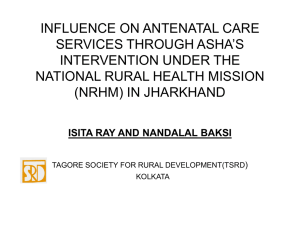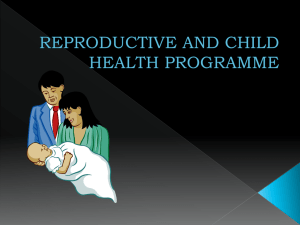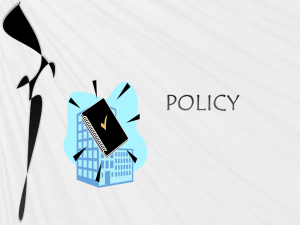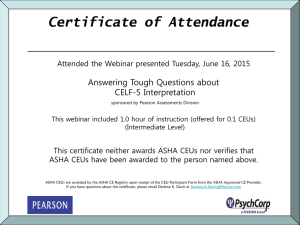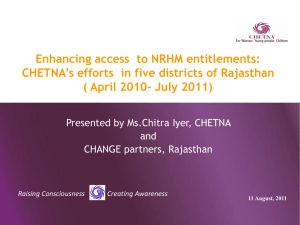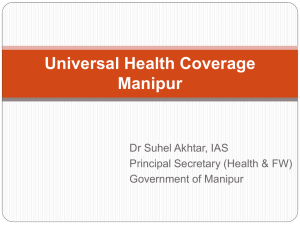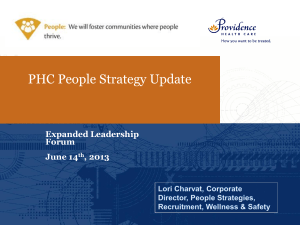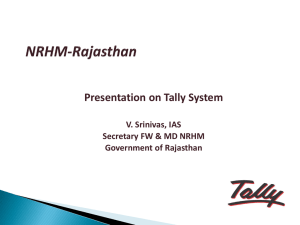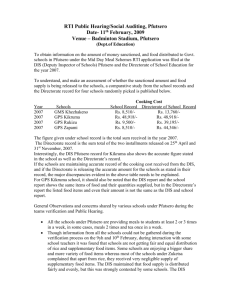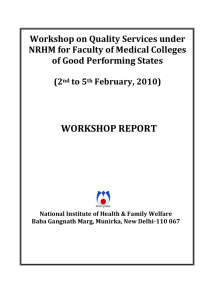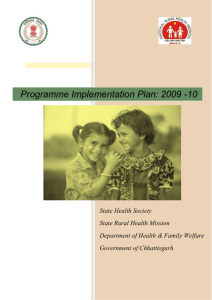Health NRHM - KENDUJHAR
advertisement
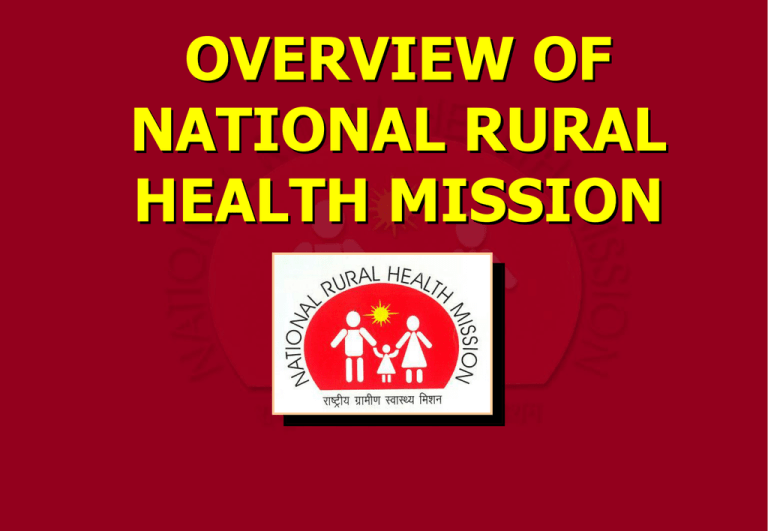
OVERVIEW OF NATIONAL RURAL HEALTH MISSION NATIONAL RURAL HEALTH MISSION National Rural Health Mission (NRHM) was launched on 12th April 2005 in India. It is one of the biggest–ever integrated health initiatives in the health sector in the last 50 years. NRHM is not a project but an over arching umbrella integrating the on going vertical programmes and addressing issues related to the determinants of health like sanitation, Nutrition, and safe drinking water. Cont… The National Rural Health Mission seeks to adopt a sector wide approach and aims at systematic reforms to enable efficiency in health services delivery. NRHM subsumes key national programmes namely the RCH II, General Curative Care, National disease control programmes and the integrated disease surveillance project. NRHM will also enable the mainstreaming of Ayurvedic, Yoga, Unani, Siddha and Homeopathy system of medicine (AYUSH). Cont… The Goal of Mission is to improve the availability of and access to quality health care by people especially for those residing in rural areas, the poor, women and children. Mission adopt a synergistic approach by relating Health to determinants of good health viz. of - nutrition, sanitation, hygiene and safe drinking water Cont… THE NRHM VISION The National Rural Health Mission (2005-12) seeks to provide effective healthcare to rural population throughout the country with special focus on 18 states, which have weak public health indicators and/or weak infrastructure. The Mission is an articulation of the commitment of the Government to raise public spending on health from 0.9% of GDP to 2-3% of GDP. EXPECTED OUTCOMES AT NATIONAL LEVEL FInfant Mortality Rate (IMR) reduced to 30/1000 live births by 2012. F Maternal Mortality Ratio (MMR) reduced to 100/100,000 by 2012. FTotal Fertility Rate (TFR) reduced to 2.1 by 2010. F Malaria Mortality Reduction Rate : 50% upto 2010, additional 10% by 2012. F Leprosy Prevalence Rate : Reduce from 1.8/10,000 in 2005 to less than 1/10,000 thereafter. EXPECTED OUTCOMES AT NATIONAL LEVEL F Tuberculosis DOTS Services : Maintain 85% cure rate through entire Mission period. F Increase Utilisation of first Referral Units from less than 20 to 75%. F Upgrading Community Health Centres to Indian Public Health Standards. FJapanese Encephalitis Mortality Reduction Rate : 50% by 2010 and sustaining at the level until 2012. FCataract Operation : Increasing to 46 lakhs per NRHM – 5 COMPONENTS NRHM Initiatives ASHA ,GKS, Untied Funds RKS , MHUs, School Health Programs , Other NRHM additionalities RCH-II Maternal/Child Health Family Planning/Tribal RCH/BCC Adoloscent Health/ Training/ Institutional strengthening INTER SECTORAL CONVERGENCE PPP Initiatives, Departmental Coordination for programs Like VHND, Pustikar Diwas DISEASE CONTROL PROGRAMME RNTCP,NLEP, Blindness Control , National Iodine Deficiency Disaster Control Programe IMMUNISATION Routine Immunization Pulse Polio Campaign Special Immunization COMPENSATION PACKAGE 1. Institutional Delivery Rural Areas Mother’s ASHA’s Package Package 1400 600 Total Rs. 2000 Motivation for Vasectomy Tubectomy • Immunization • DOTs Provider Urban Area Total Mother’s ASHA’s Rs. Package Package 1000 200 1200 @ Rs. @ Rs. @ Rs. @ Rs. 200 100 150 250 (Per case) (Per case) (Per session) (on completion of ASHA • Every one thousand population there will be a ASHA • ASHA act as a bridge between the ANM and the village and be accountable to the Panchayat. • She will be an honorary volunteer, receiving performance-based compensation. • She will promote institutional delivery, universal immunization, referral, escort services for RCH and other health care delivery programmes. • She will facilitate in preparation of village health plan along with ANM/AWW under leadership of village health & sanitation committee. Untied fund at Sub Centre level Rs.10000/- per SubCentre per annum to be kept in joint account of Sarpanch and ANM. To be spent on:– Minor repair of Sub Centre. – Payments for cleaning after child birth. – Transport during emergency to appropriate referral centre. • Transport of samples during epidemics. • Payment of wages for environmental sanitation. • Payment/Reward to ASHA for certain specific activities. • Should not be used for Salary, Vehicle purchase & expenses of Gram Panchayat. Upgrading CHCs as per Indian Public Health Standard. Provision quality service round the clock referral care at CHC level is an important strategic intervention under NRHM. In order to ensure quality of services, the Indian Public Health Standards are being set up for CHCs so as to set up a yard stick to measure the services being provided. The Programme includes provision of : • OT/ Labour room/ X-Ray etc. • Blood transfusion facilities. •LSAS doctors at each L-3 institutions Rogi Kalyan Samiti – RKS at every District, Sub-Division and Block Level Hospital. – RKS is a registered society for better management of hospitals with people’s participation. – Corpus Fund from Govt. of India –Rs. Five Lakhs per District Headquarters Hospital –Rs. One Lakh per Sub-Divisional Hospital and CHCs/ PHCs. Mobile Medical Units – Under NRHM Mobile Medical Unit to be functional in each tribal blocks to supplement existing system in remote inaccessible areas. – Each Mobile Medical Unit will have Specialist services Mainstreaming AYUSH Seeks to revitalize local health traditions and mainstream AYUSH infrastructure, manpower and drugs. Space shall be provided for AYUSH practitioner and pharmacist in CHCs/ PHCs. PHC(N) shall be upgraded to include two Doctors by inducting AYUSH practitioner. Ayurveda Homoeopathy Unani Siddha Yoga and Naturopathy Intersectoral Convergence NRHM envisage that determinants of health, like sanitation, nutrition and safe drinking water influences general health to a large extent. Therefore it is considered necessary to forge linkages with department of Women & Child Development, Rural Development Department, Education, Panchayat Raj, Rural Water Supply & Sanitation Department. Cont… Stakeholders Ongoing Programmes : 1.Reproductive & Child Health (RCH) Programme - II. Reproductive and Child Health (RCH) Programme-II is an ongoing programme under NRHM, with the objective of improving the Reproductive Health of men and women and the health of children from 2005-12 The focus of the programme is to reduce the Maternal and Child Mortality and Morbidity with emphasis on rural health care. Adolescent Health and Gender, Urban Health, Tribal Health and Public Health and Public Private Partnership are the other supporting focus areas in RCH-II. Components of RCH II Maternal Health • Quality ANC, PNC – VHND, Anemia prophylaxis, TT, early diagnosis of complication, Birth planning • Institutional Delivery –Infrastructure strengthening, Incentives, referral system • SBA • Provision of BEmONC & CEmONC services • Availability of FP services for limiting/Spacing • Safe Abortion • Janani Express at each health institutions Components of RCH II Child Health • • • • • • Institutional delivery with 48 hrs stay SNCU I & II NSSK Immunization strengthening Pustikar Diwas, VHND IMNCI Components of RCH II Family Planning • Expanding facilities & choices – Fixed day centers – Limiting methods • Minilap • Laparoscopic • NSV – Spacing methods • IUCD – Skill enhancement – RTI/STI treatment at PHC level • OP/CC – ASHA is a depot holder • QAC – To provide quality services VILLAGE HEALTH& NUTRITION DAYS…MAMATA DIVAS Village level interventions for addressing Maternal & Child Health issues. Organised monthly at Anganwadi Centres through the coordinated efforts of ANM, ASHA, AWWs. 23 PUSTIKAR DIWAS To effectively combat the problems of malnutrition and to reduce malnutrition rate in Orissa (from 44% to 35% by 2012 NRHM Goal) Pushtikar Divas has been devised. This activity is one of the strategic interventions by Health & Family Welfare and Women & Child Development departments to address malnutrition. This is to be organized once on the 15th of every month, in the Block PHC/CHC. Children in the Grade - II, III, IV or moderate to severely malnourished shall be referred by the AWW/ANM to the Block PHC/CHC for management & treatment. The Medical Officers shall undertake the treatment as per the defined treatment protocol. At the block, PHC/CHC Medical Officers are required to undertake detailed examination, possible investigation, diagnosis and treatment of referred children, as per the treatment protocol. School Health Programme • Address holistically the health and nutrition needs of children in a manner which fulfils the needs of today's lifestyle • For preventive, promotive and curative services to the school children • Around 2848 schools will be covered • Around 2,80,000 children will be screened • It will be an inter-sectoral effort Components of SHP Screening, health care and referral Immunization (TT-10) De-worming School-based activities promoting good health Monitoring & Evaluation GKS Formation Processes • Revenue village is the unit of GKS formation • Ward member is the chairperson, Anganwadi Worker is the convener, ASHA supports the functioning of GKS Rs. 10,000/- untied fund per annum Immunization : Immunization is one of the foremost Public Health Programme in the country. It is the need of the hour to reach every child and mother and deliver health services. This is an emerging process and the goal is to 100% immunization status by 2010 in the district. Immunization is a key intervention under NRHM and major activities include •Routine immunisation • Intensified Pulse Polio immunization. • Maintenance of Cold Chain Procedure National Disease Control Programme : National Vector Borne Programme (Malaria) Disease Control The goal of the NVBDCP programme is to reduce Malaria death by 50% by 2012. Vector control activities are parasite index and in areas with resistance to synthetic Parathyroid. Larvivorous fish and treated bed nets have been distributed. Besides BCC activities have been undertaken in the community by creating awareness. National Programme Blindness for control of The goal of the programme is to reduce the prevalence of blindness to 0.8% by 2012. To realize the goal, cataract surgery, screening of students for refractive errors & correction, eye collection & training of workers & teaches ect are being conducted in the state. Revised National Programme (RNTCP) Tuberculosis Control RNTCP is uniformly operational across the state through the strategy is directly observed treatment short course(DOTs). The chest symptomatic are subjected to sputum examination & patients positive for acid fast bacilli are provided full course of treatment under the direct supervision of DOTs provider. Success rate of new smear positive case is 85%, case detection is 54% & seamer conversion is 86%. National Leprosy Elimination Programme (NLEP) The objective of the programme is to eliminate leprosy by bringing all the cases of leprosy under Multi Drug Therapy (MDT). As of now 20 districts have achieved leprosy elimination status. This has been possible, as a result of intense BCC activities, training integrated of vertical infrastructure of leprosy into general health. Areas of the Project Area of operation • 13 Blocks of this district • 286 GPs of this district • 2060 villages of this district HEALTH INSTITUTIONS OF KEONJHAR DISTRICT District Head Quarter Hospital Sub-Divisional Hospital Community Health Centre Single Doctor PHC (PHC New) Sub-center Total : 01 : 02 : 17 : 66 : 351 :437 Scope for private participation • Handing of PHC (N)/SC to Corporate houses /NGOs for management purposes where health service providers are not available • Collaboration with the corporate houses organising different health camps and Mega Swasthya Mela. • Vulnerable group sensitisation and mobilisation. • Adoption of different wards in DHH/SDH for management purposes and beautification of hospitals Strengthening the local government (PRIs & Communities) • Through GKS capacity building the PRIs and the communities can be sensitised and ownership can be developed for health seeking behaviour. • Capacity building of RKS members Practical problem/issues • Delay in constructional activities • Vacancy of Medical Officers and other paramedical staff in rural health institutions. • Delay in referral by the community. • Fill up the paramedical persons immediately in the drive mode. • Promotion of 2nd referral system in all the Block CHC by providing hired ambulances Specific problem Banspal: 1. Posting of Doctors (5 Nos), staff nurses (6 Nos) , HW(F) & Addl. HW(F), HW(M) in all the health institution of Banspal Block 2. Ambulance provision at CHC 3. Adoption of few institutions under PPP mode by NGO/NYK/Corporate houses where the service providers are not available (4-5 sub-centers) 4. Sensitisation among the service providers about the service delivery system 5. Infrastructure development at PHC (N),SC- 1 No. SC constru. 6. IEC/BCC activities at community and service providers level 7. Incentive packages for HW(F) and ASHA for service delivery Telkoi 1. Posting of Doctors, staff nurses (6 Nos.) , HW(F) (5Nos)& Addl. HW(F), HW(M) 2. Adoption of few institutions under PPP mode where the service providers are not available 5 PHC(N) ( Kaliahata, Raisuan, Krushnapur, Jagamohanpur, Sirigida) & SC-5 (Talapada, L.N.. Pur, Kaliahata, Raisuan, Karadangi) 3. Sensitisation among the service providers about the service delivery system 4. Infrastructure development at PHC (N),SC 5. IEC/BCC activities at community and service providers 6. Incentive packages for HW(F) and ASHA for service delivery Harichandanpur 1. Posting of Doctors, staff nurses , HW(F) & Addl. HW(F), HW(M) 2. Adoption of few institutions under PPP mode where the service providers are not available 2 PHC(N) ( Kalapata, Rebenapalaspal, 3. Posting doctors and other paramedical staff at Bhagamunda 4. Sensitisation among the service providers about the service delivery system 5. Infrastructure development at PHC (N),SC- 6 Nos. 6. IEC/BCC activities at community and service providers 7. Incentive packages for HW(F) and ASHA for service delivery Basudevpur 1. Posting of Doctors, staff nurses , HW(F) & Addl. HW(F), HW(M) 2. Adoption of few institutions under PPP mode where the service providers are not available 2 PHC(N) ( Kalimati, Guali) to corporate houses 3. Sensitisation among the service providers about the service delivery system 4. Infrastructure development at PHC (N),SC- 15 Nos. 5. IEC/BCC activities at community and service providers 6. Incentive packages for HW(F) and ASHA for service delivery
